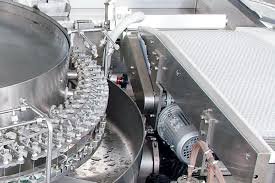Describe the standard qualification process for a vial washing machine.

Here’s a comprehensive and detailed explanation of the standard qualification process for a vial washing machine used in pharmaceutical manufacturing:
Standard Qualification Process for a Vial Washing Machine
Qualification is a critical aspect of pharmaceutical equipment validation. The vial washing machine is used to clean vials prior to sterilization and filling, making its qualification essential to ensure the removal of particles, microbial contaminants, and residues. The process is carried out in stages as per Good Manufacturing Practices (GMP) and regulatory guidelines (e.g., US FDA, EU GMP, WHO).
The qualification process typically includes five main stages:
1. User Requirements Specification (URS)
Purpose:
To define what the user expects the vial washing machine to do.
Key Elements:
-
Vial size compatibility (e.g., 2 mL, 10 mL, 20 mL)
-
Washing media (e.g., purified water, WFI, compressed air)
-
Output capacity (vials per hour)
-
Design requirements (e.g., SS316L contact parts)
-
Safety, automation, and control system expectations
-
Compliance with GMP and applicable standards
2. Design Qualification (DQ)
Purpose:
To confirm that the design meets the URS and complies with GMP standards.
Activities:
-
Review of equipment design and technical drawings
-
Evaluation of material of construction (corrosion-resistant, cleanable)
-
Assessment of control systems, automation, alarms
-
Verification of cleaning and maintenance accessibility
-
Confirmation of vendor specifications and documentation
Output: DQ Report including approvals from engineering, quality, and production teams.
3. Installation Qualification (IQ)
Purpose:
To ensure the equipment is installed correctly and according to the manufacturer’s specifications.
Key Checks:
-
Verification of correct installation in a suitable environment (cleanroom area)
-
Electrical supply, compressed air, and water connections as per spec
-
Instrumentation calibration certificates (e.g., pressure gauges, temperature sensors)
-
Verification of lubrication points, belts, motors, and pumps
-
Check for installation of spray needles, vial holders, and conveyors
-
Review of manuals, wiring diagrams, spare parts list
Output: IQ Report confirming the machine is ready for operational testing.
4. Operational Qualification (OQ)
Purpose:
To confirm the machine operates correctly under defined conditions.
Tests and Verifications:
-
Start-up and shutdown sequence
-
Verification of operating parameters:
-
Washing cycle timing
-
Water and air pressures
-
Spray needle motion
-
-
Functioning of control panel and HMI (Human-Machine Interface)
-
Safety features and interlock testing
-
Alarm testing and fail-safe mechanisms
-
Dry run test without load to observe functionality
Output: OQ Report with test results, deviations (if any), and corrective actions.
5. Performance Qualification (PQ)
Purpose:
To verify the machine performs consistently and reliably under actual production conditions.
Procedures:
-
Use of actual vials to simulate production runs
-
Different batch sizes: minimum, nominal, and maximum loads
-
Testing vial cleanliness:
-
Particle count (via particle counter or visual inspection)
-
Bioburden level (microbial testing)
-
Endotoxin testing (especially for parenteral drugs)
-
-
Repeatability testing (3 consecutive successful runs)
-
Monitoring and documenting cycle parameters
Output: PQ Report confirming the machine meets performance specifications.
Documentation and Final Report
All qualification stages should be documented and approved. The final Qualification Summary Report should include:
-
Summary of each qualification stage (URS, DQ, IQ, OQ, PQ)
-
Deviations and corrective actions (if any)
-
Overall assessment and approval from QA
Conclusion
The qualification of a vial washing machine ensures:
-
Compliance with regulatory standards
-
Consistent and effective vial cleaning
-
Protection of product integrity and patient safety
By following this systematic approach, pharmaceutical companies can assure that the equipment is fit for its intended use and performs reliably during routine production.
🎓 Discover one of the best Pharmaceutical Production courses available — click below to explore the course that’s shaping future Production skills.

